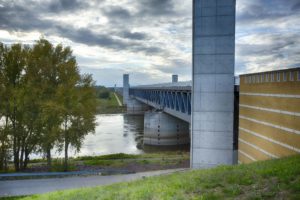
About Wolmirstedt
The city of Wolmirstedt with its districts Elbeu, Farsleben, Glindenberg and Mose is located about 12 km north of the state capital Magdeburg between the Magdeburger Börde and the Colbitz-Letzlinger Heide.
As of 31.12.2022, 12,050 inhabitants live in the entire town on an area of 55 km² and 8566 inhabitants in the core town. Our city area has an exceptionally convenient location. The A2 and A14 are quickly accessible via the four-lane federal highway 189. Furthermore, Wolmirstedt is located directly at the waterway junction Magdeburg (Elbe-Mittellandkanal) and has very good rail connections due to the railroad line Magdeburg – Stendal – Uelzen. Included here is the local public transport through the municipal transport company BördeBus. In the city there are 7 day care centers, two elementary and secondary schools, one of which is run as an all-day school, one special school and one high school. In addition, the Börde District Music School, the Börde District Adult Education Center and the Technical School for Social Pedagogy are located here. The citizens of the town have at their disposal a wide range of cultural and sporting leisure facilities, including a community center, a library, a swimming pool, tennis courts, a health center, an educational and recreational center, as well as clubs and social facilities. Medical care is provided by general practitioners and specialists. Wolmirstedt has a number of culturally and historically interesting buildings and a green surrounding countryside. The city lies on the Jacobus Pilgrimage Route through Saxony-Anhalt and the Aller-Elbe Cycle Route also passes through Wolmirstedt.
Thus, Wolmirstedt with its facilities and its differentiated residential offers presents itself as an attractive place to live. The advantages of the unified municipality are particularly strengthened by the safe and attractive route connections as well as the economic, cultural and social links to our neighbors.
The village of Wolmirstedt was first mentioned in writing in 1009 in the chronicle of Bishop Thietmar of Merseburg.
Population development
1564 100 families
1646 12 inhabitants
1782 1069 inhabitants
1861 3947 inhabitants
1932 4871 inhabitants
1939 5518 inhabitants
1974 11200 inhabitants
1994 10542 inhabitants
2014 11762 inhabitants
2021 11810 inhabitants
2022 12050 Inhabitants
Coat of arms
 The coat of arms of the city shows on a silver background St. Catherine with golden hair and golden nimbus in a red robe. In her right hand she holds a tumbled silver sword with a golden guard and golden hilt, in her left a broken golden wheel with five spokes and four prongs; in front of her feet a blue shield with a silver fleur-de-lis.
The coat of arms of the city shows on a silver background St. Catherine with golden hair and golden nimbus in a red robe. In her right hand she holds a tumbled silver sword with a golden guard and golden hilt, in her left a broken golden wheel with five spokes and four prongs; in front of her feet a blue shield with a silver fleur-de-lis.
 The colors of the city are blue and white. The city flag is divided diagonally into two fields, blue in the upper left field and white in the lower right field. In the center it contains the coat of arms of the city.
The colors of the city are blue and white. The city flag is divided diagonally into two fields, blue in the upper left field and white in the lower right field. In the center it contains the coat of arms of the city.
Castle domain
The 8000 m² area is the historical and cultural center of the city. A comprehensive renovation took place in the years 2005 to 2007. The medieval ensemble of buildings includes the castle palace on the upper castle. From 1576 to 1598 the administrator Joachim Friedrich and his family lived here. The district court has been located here since 1795. One of the most beautiful and significant buildings of the castle domain is the castle chapel, completed in 1480 under Archbishop Ernst II of Wettin. He had it built as a single-nave brick building in the late Gothic style. During the summer months, marriage parties can tie the knot in this historic setting. The manor house, built in 1770 and once the residence of the tenants of the domain, now serves as the headquarters of several associations and as a venue for cultural events.
The district museum including the castle store has been located in the quarry stone barn from 1846 since 1981. It displays exhibitions on the history of the city, natural history, historical workshops and various special exhibitions. A special offer are evening walks through historic Wolmirstedt and tours of the city’s churches.
The former stables of the domain house the municipal library
Since 2008, the town’s own museum barn has been used for cultural events and celebrations in addition to the privately run Katharinensaal.
Originally, the river Ohre flowed into the Elbe at the foot of the castle hill. In the 13th century, the Elbe sought a new riverbed and the Ohre has since then flowed alone through the city from west to east.
St. Catherine’s Church
Worth seeing is St. Catherine’s Church, built in 1876 in the neo-Gothic architectural style. Originally built with an open roof truss and galleries, it could no longer be used for the congregation after a fire in 1973. In 1976 – 1981, hardly visible from the outside, a complete reconstruction of the church interior on two floors took place. In 2012, extensive restoration of the facade and roof took place. The organ, which sounds on various occasions, was built in 1989 by the company Böhm from Gotha; it has two manuals, 21 stops and 1558 pipes.








